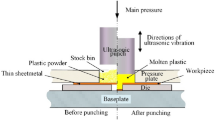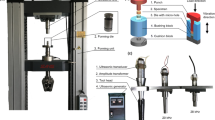Abstract
Investigations have revealed that size effect obviously affects forming quality and accuracy of micro parts. However, to find effective approaches that can reduce the influence of size effect is still a critical problem to be solved. Ultrasonic vibration has been widely used in industrial metal forming recently, and it has been proved that it is helpful for improving section quality compared with conventional blanking. In this study, micro-blanking process was carried out with a specially developed device. The square holes of copper foil T2 were investigated by analyzing the evolution of microstructure, crack initiation, quality of shearing surface, etc. Inhibition of crack initiation is found due to the softening effect in ultrasonic vibration assisted micro-blanking by analyzing section obtained under different ratios of blanking stroke to thickness (h/t), which increases the ratio of smooth zone. The analysis of microstructure in deformation area shows that a shearing deformation area becomes smaller, and radius of fillet decreases. Surface roughness of smooth zone decreases with ultrasonic vibration due to polishing effect. Compared with traditional micro-blanking, this compound plastic forming technology applying ultrasonic vibration on the punch can improve the section surface quality by increasing the ratio of smooth zone, and decreasing the surface roughness and fillet radius. The experimental outcomes reveal the mechanism of shearing deformation behavior during ultrasonic vibration assisted micro-blanking process of copper foil and the findings confirm that ultrasonic vibration can be regarded as a way to improve the forming quality of micro-blanking.
Similar content being viewed by others
References
Geiger M, Kleiner M, Eckstein R, Tiesler N, Engel U (2001) Microforming. CIRP Ann Manuf Tech 50:445–462
Meng B, Fu MW (2015) Size effect on deformation behavior and ductile fracture in microforming of pure copper sheets considering free surface roughening. Mater Des 83:400–412
Fu MW, Chan WL (2013) A review on the state-of-the-art microforming technologies. Int J Adv Manuf Technol 67:2411–2437
Razali AR, Qin Y (2013) A review on micro-manufacturing, micro-forming and their key issues. Process Eng 53:665–672
Xu ZT, Peng LF, Fu MW, Lai XM (2015) Size effect affected formability of sheet metals in micro/meso scale plastic deformation: experiment and modeling. Int J Plast 68:34–54
Wang CJ, Wang CJ, Xu J, Zhang P, Shan DB, Guo B (2016) Interactive effect of microstructure and cavity dimension on filling behavior in micro coining of pure nickel. Sci Rep 6:23895–23904
Wang CJ, Shan DB, Guo B, Sun LN (2007) Size effects of the cavity dimension on the microforming ability during coining process. J Mater Process Technol 187–188:256–259
Xu J, Guo B, Wang CJ, Shan DB (2012) Blanking clearance and grain size effects on micro deformation behavior and fracture in micro-blanking of brass foil. Int J Mach Tools Manuf 60:27–34
Wang CJ, Guo B, Shan DB, Bai XM (2015) Effects of interfacial contact stats on tribological behavior in micro sheet forming. Int J Mech Sci 101–102:81–88
Wang CJ, Guo B, Shan DB, Zhang MM, Bai XM (2014) Tribological behaviors in microforming considering microscopically trapped lubricant at contact interface. Int J Adv Manuf Technol 71:2083–2090
Lum I, Huang H, Chang BH, Mayer M, Du D, Zhou Y (2009) Effects of superimposed ultrasound on deformation of gold. J Appl Phys 024905:1–5
Siddiq A, Sayed TE (2011) Acoustic softening in metals during ultrasonic assisted deformation via CP-FEM. Mater Lett 65:356–359
Siddiq A, Sayed TE (2012) A thermomechanical crystal plasticity constitutive model for ultrasonic consolidation. Comput Mater Sci 51:241–251
Huang Z, Lucas M, Adams MJ (2002) Influence of ultrasonics on upsetting of a model paste. Ultrasonics 40(1–8):43–48
Huang Z, Lucas M, Adams MJ (2002) Effect of ultrasonic vibration on wedge indentation of a model elasto-viscoplastic material. Proc SPIE Int Soc Opt Eng 4537:445–448
Hung JC, Tsai YC, Hung C (2007) Frictional effect of ultrasonic-vibration on upsetting. Ultrasonics 46(3):277–284
Daud Y, Lucas M, Huang ZH (2007) Modeling the effects of superimposed ultrasonic vibrations on tension and compression tests of aluminium. J Mater Process Technol 186:179–190
Yao ZH, Kim GY, Wang ZH, Faidley L, Zou QZ, Mei DQ, Chen ZC (2012) Acoustic softening and residual hardening in aluminum: modeling and experiments. Int J Plast 39:75–87
Wang CJ, Liu Y, Guo B, Shan DB, Zhang B (2016) Acoustic softening and stress superposition in ultrasonic vibration assisted uniaxial tension of copper foil: experiments and modeling. Mater Des 112:246–253
Siu KW, Ngan AHW, Jones IP (2011) New insight on acoustoplasticity—ultrasonic irradiation enhances subgrain formation during deformation. Int J Plast 27:788–800
Dutta RK, Petrov RH, Delhez R, Hermans MJM, Richardson IM, Bottger AJ (2013) The effect of tensile deformation by in situ ultrasonic treatment on the microstructure of low-carbon steel. Acta Mater 61:1592–1602
Lou Y, He JS, Chen H, Long M (2016) Effects of vibration amplitude and relative grain size on the rheological behavior of copper during ultrasonic-assisted microextrusion. Int J Adv Manuf Technol:1–13
Huang YM, Wu YS, Huang JY (2014) The influence of ultrasonic vibration-assisted micro-deep drawing process. Int J Adv Manuf Technol 71:1455–1461
Bunget C, Ngaile G (2011) Influence of ultrasonic vibration on micro-extrusion. Ultrasonics 51:606–616
Bai Y, Yang M (2013) Investigation on mechanism of metal foil surface finishing with vibration-assisted micro-forging. J Mater Process Technol 213:330–336
Yeh W, Chu T, Wang S, Fuh K, Chen K (2011) Finite element analysis of blanking process by superimposing ultrasonic vibrations. Adv Mater Res 201–203:126–132
Kakemasu T, Yamasaki S, Miura H, Ozaki T (2005) Development of new piercing system for micro-holes by continuous striking of a punch using ultrasonic vibration. Proceeding of the 8th ICTP
Witthauer AT, Kim GY, Faidley LE, Zou QZ, Wang Z (2014) Effects of acoustic softening and hardening in high-frequency vibration-assisted punching of aluminum. Mater Manuf Process 29:1184–1189
Author information
Authors and Affiliations
Corresponding author
Rights and permissions
About this article
Cite this article
Liu, Y., Wang, C., Han, H. et al. Investigation on effect of ultrasonic vibration on micro-blanking process of copper foil. Int J Adv Manuf Technol 93, 2243–2249 (2017). https://doi.org/10.1007/s00170-017-0684-4
Received:
Accepted:
Published:
Issue Date:
DOI: https://doi.org/10.1007/s00170-017-0684-4




